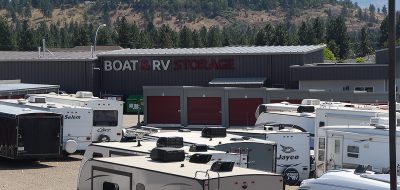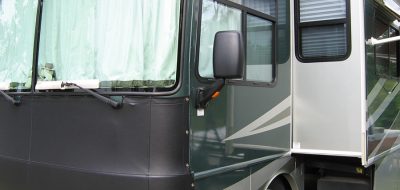Most automobiles need only three instruments, a speedometer, a voltage meter and a fuel gauge. The rest can be handled by warning lights, also referred to as “Idiot Lights.” Even tachometers have little actual application in most family cars, SUV’s and trucks. Yet the majority of these vehicles have a host of gauges, speedo, tach, oil pressure, engine temperature, voltage, fuel, etc. But what about motorized RV’s and RV tow vehicles? Do they also have the market driven instrument overkill? Probably not.
Many RV owners would like a dash that looks like it was taken from a Boeing 747. Mostly a guy thing I think. But, the gauge readouts required by most RV’s and tow vehicles are far greater than that of a passenger auto. Let’s look at what those readouts need to provide.
Speedometer – Well, that goes with out saying. Without one, you may have to pay many speeding fines. In addition, the speedo in this application may also be used to synchronize shift points for deceleration and compression brake engagement. For the cost of motorized RV’s today, I don’t know why they do not come with switchable mile/km units like found on some autos. These are analogue gauges that recalibrate from one to another at the push of a button.
Tachometer – Monitoring engine speed is critical to maintain adequate engine cooling while climbing a grade or operating within a desired torque band. It is also required to properly manage downhill speed when using engine or compression type brakes.
Fuel Level – Pretty well a no-brainer. You could use a specific number of miles driven since fill up, but with the varied fuel consumption of a vehicle that has the aerodynamics of a cinder block, it’s not real wise. Keep in mind though, these are indicators only and in no way are they accurate through their entire scale. Each one has its own personality that the owner will eventually get to know.
Volt Meter – This gives the operator a read out of approximately how much voltage the chassis currently has. A dropping reading may pre-warn of an electrical failure allowing the driver adequate time to pull over.
Engine Temperature – Observing the increments of engine heat change aids in making needed corrective measures while operating in more severe weather or geographical terrain. The “Idiot” light approach here would be too much too late. This readout is also necessary to determine that the engine is sufficiently cool enough to shutdown, particularly if turbo charger equipped.
Transmission Temperature – Transmissions in heavy RV’s and tow vehicles are often operated in extreme conditions while climbing or descending grades. Running gear temperature management needs this input to stay within the safe operating temperature range. Transmissions can be cooled if needed by stopping and running the engine in neutral at a speed slightly higher that idle.
Engine Oil Pressure – While most people rarely look at this indicator, it can be observed if a low pressure alarm sounds. If the oil pressure drops abruptly, it may be due to a failed sensor. In this event sometimes a low engine RPM can produce an adequate oil pressure, whereas a higher RPM not. Having an analogue readout is a blessing in this case and may allow a driver to safely move off the road or limp to a repair shop.
Air Pressure – (Applicable to most diesel pushers) There are two air pressure gauges used for this application, a primary and a secondary. The primary displays the air pressure currently available in the tank supplying the rear brakes. The secondary air gauge displays the pressure available for the front brakes, suspension and pneumatic accessories. The secondary tank is many times a partitioned vessel shared with the wet tank supply. Both systems are relatively independent. In the event of an air pressure failure in either system, an alarm will sound prior to the system becoming inoperative. The calibrated readout can then be used to monitor the system while getting off the road prior to the automatic rear drive axle brake application.
The following are additional readouts that, while not being a necessity, can be a nice addition.
Turbo Pressure – (Only applicable to turbo charged vehicles) Perhaps for general use it is more a macho gauge, but it can also be a great component health meter. This can give you early warning of an air charge cooler or turbo failure.
Intake Temperature – Displaying the air temperature at the intake manifold shows the after-cooler’s efficiency on a turbo charged engine. Most modern turbo diesels will de-rate the power if the air intake temperature gets within a set temperature difference from that of the engine. Hard climbing can increase this temperature.
EGT (Exhaust Gas Temperature) – Generally this applies to gasoline powered engines. This measures the exhaust gas temperature and can warn of an excessively lean fuel mixture. Though modern gas engines self monitor and adjust this as needed, it could, if unchecked, severely damage the pistons, valves and other engine components.
OAT (Outside Air Temperature) – A handy thing to know if operating in near freezing temperatures. Ice forming on the road surface can cause traction issues for any vehicles, but for heavy class A’s and towing combinations it is particularly dangerous.
Well, that pretty well covers it. While there are other gauges available on the market like intake vacuum or engine oil temperature, these are not what I consider necessary for an RV application.
Many, if not all, of these gauges are available in analogue or digital. I prefer analogue in most cases, particularly for speed and RPM. This is due to the fact that you can quickly observe their position or angle without the need to actually read them. In that sense, it may allow you to react faster in an emergency situation.
So, what readouts do you have? Any I missed? Next week we will examine an instrument that may pay for itself over time in fuel savings. The onboard fuel computer.
With An En-Gauging Thought – Lug_Nut – Peter Mercer







Pingback: klonopin
Pingback: viagra
Pingback: mangafox
Pingback: Book
Pingback: Wind
Pingback: ambien
Pingback: cheap viagra
Pingback: viagra
Pingback: cialis
Pingback: viagra
Pingback: Autoapprove List
Pingback: I've said that least 4265778 times
Pingback: עיצוב גינות
Pingback: kaloritabell
Pingback: Bedroom Furniture Sets
Jeff
Peter, I enjoyed reading up on the SilverLeaf product and intend to check it out further. Now that my coach is out of warranty, I’m in the mood to play around with it some. At 65, however, I’m not as handy with electronics as I once was but I’ll bet I can find someone who can make that data port under the dash work for me.
Jim, I agree that manufacturers design and market for the largest segment of any market. But, people who buy RVs either are, or are soon to be, more technologically savvy than the average citizen, in my opinion. Regardless of gender or age, when you start operating and using these things, you have to learn really fast. Just how fast determines on which side of the expensive repair you achieve a working understanding of your RV and its systems.
I was trained as a jet aircraft crew chief and have also done some flying so, I think I have a pretty good grasp of systems. But reading all the owner’s manuals, tech articles and especially these tech blogs has helped me with my understanding and behavior modification when it comes to the operation and maintenance of my coach. I’m eager to enter full-time retirement in a couple of years so I can start attending some of the rallies to discover what new goodies are available.
Thanks, guys.
Lug_Nut
Barney, The altitude feature in a fun thing to have and also offers some practical applications too. Thank you for your post.
Barney
I have a Garmin Nuvi 750 and a GPS-5. The GPS-5 has an on-screen display of altitude, but the Nuvi does not. Both, however record altitude in the track data which can be downloaded from the unit, I have several plots from traversing Lake Agaziz here in ND. I also plot elevation for all of our camping excursions. While the Nuvi 750 (now obsolete as well) doesn’t have a live elevation readout, the data is there.
Lug_Nut
Bruce shand, Most automobile designed GPS navigation systems do not include the altitude as a function or readout. Thank you for your input on this topic.
Bruce shand
I guess an altimeter is neat but if you have a GPS it’s redundant. GPSs can display altitude relative to sea level. At least the ones I’ve used can.
Lug_Nut
manson polley, It sounds like you are really using those instruments the way they should be. This certainly can reduce fuel consumption and add longer life to your engine and running gear. Thanks for sharing this with us.
manson polley
Bought my first MH in 72 and installed a 4″ diam, 270 degree sweep 4000rpm tach and vacuum gauge same size, i.e. easy to read at a glance. Looked up peak torque for my engine and found that I used these gauges more than any other to keep rpm at or above torque peak with max vacuum reading. I manually kick off overdrive and/or downshift based on vac/rpm readings both up and down hill, and have had great results in both mpg and minimal maint problems. Upgraded to a 94 MH with Ford 460 and immediately added same two gauges. Was lost without them on the new rig. Have over 101,000 miles on my 94 and think they were positively worth the $$ and time to install. Highly recommend both.
Lug_Nut
Jim, You are probably very right. But for those with instruments they do not understand, they should really read up on the actual application of each. Thank you for sharing your experience with us.
Lug_Nut
Jeff, There are many coaches with very basic instruments. You can, however add one that make sense to you. Some products like SilverLeaf can add many read-outs in one. Thank you for your input on this topic.
Jim
Jeff, I have been dealing with the general public for over thirty five years, in automotive repair and other retail. The general public is not well informed on these topics or items.( for lack of better names) I would not call them idiots, they just don’t know anything about such items. This why fourty years ago basicaly all they had were idiot lights. People did not understand gauges or how to read them or what they meant. The maufactors build things to the largest group of buyers, no matter how uninformed they may be. I fine example would be a voltmeter, some say charge and discharge, people do not know what the voltage should be nor do they care.
Jeff
Peter, thanks for the link to your ’08 article. I’m with you. But, how do we get the manufacturers interested in these needs? The panel in my coach is extremely basic. Is it like Art said: they must think we’re all idiots or too simple to understand, interpret and effectively use all this info the systems are capable of providing. If we’re as stupid as these instrument displays would infer, we should not be driving these things!
Lug_Nut
Bill Forrest, Good point and thank you for bring that to my attention. Not only the genset but also those that have AquaHot or like diesel fired boilers as they too are on a shorter pick-up tube. Thank you for your very good input.
Bill Forrest
the fuel gauge comment might have also included the info that under 1/4 tank of fuel your gen prolly won’t start or run because of that fuel level.
Lug_Nut
jerome jefferson, Great point. On a diesel the EGT can be used to safeguard the turbo charger. If the heat gets too high the turbine blades can disform and become damaged. The ECM in most modern diesel engines look after this by measuring the temperature and, if needed, turning down the fuel delivery. Thank you for bring this up and for your valued input.
jerome jefferson
EGT (Exhaust Gas Temperature) – Generally this applies to gasoline powered engines. This measures the exhaust gas temperature and can warn of an excessively lean fuel mixture. Though modern gas engines self monitor and adjust this as needed, it could, if unchecked, severely damage the pistons, valves and other engine components.
I have a Ford F-350 w/7.3 diesel. The EGT is invaluable when pulling my 12000 lb 5th wheel. On a gasser it might mean lean, but with a diesel, it means back off or down shift.
Lug_Nut
Jeff, Yes I agree with the issue of dealing with multi-page read-outs, very difficult to change quickly while underway. I would also agree on having both analogue and digital would be great. SilverLeaf has that option on some of their models of the Glass Dash. Your point on heads-up is good. I wrote about similiar some time ago, here http://blog.rv.net/2008/01/looking-ahead-at-instrumentation/
Thank you for your great input.
Lug_Nut
Eldon, Very interesting on your use of your vacuum gauge. Generally people have just seemed to use it as a thottle reading, keeping it high brought higher mileage. Yes the tire monitor is a bonus instrument. It is included somewhat in next week’s topic. Thank you for taking the time to post.
Lug_Nut
Art, Yes most chassis makers use both read-outs and full gauges, but typically, once the warning light turns on the dog stuff already hit the fan. Your issue with night driving is more common with white faced gauges. Perhaps extenal infared similiar to that used in many aircraft may be an answer. All you really need to see is the needles, that will give you a pretty go idea what the reading are. As usual Art, thanks for your great input.
Jeff
I’m with Eldon: I love gauges! We have an ’08 32ft gas powered Class A and live @ 6,200 feet elevation in the Teton mountains of southeastern Idaho. So everything relevant to a gas powered vehicle in the mountains including OAT, EGT and altimeter is VERY helpful. The instrumentation aboard my W22 Workhorse with GM Vortec and Allison 6-speed provides almost everything I need to make informed operating choices but, sadly, the display falls way short in delivering it to the driver. Many options for information are available for display in the instrument cluster but have to be manually selected by operating pushbuttons stepping through sequential menus – not safely done while underway! AND another maddening thing is, you may need several of the individual readouts simultaneously; made impossible by the design of the display. Do the people who build these things ever drive and live in them like we do?
As to the comments about digital versus analog display format: why not have both? The argument for the pointer angle is very valid but, some operators do equally well with digital. Display technology today is more than capable of giving us all of these options simultaneously. So, I say, why not have it? If I ever get to speak with a factory rep in person, this would be my message to them. I know everyone is different and some may consider this overkill. But the technology is there and can be made to allow for the operator to program his preferences. I also believe that the time is right for the introduction of the heads up display (HUD) into the motor vehicle world. Think about that the next time you drive on Interstate freeways in a major metropolitan area: do you dare take your eyes off the road and rearview mirrors long enough to look at your coach’s performance indicators? I really sympathize with Art’s predicament in his DP Monaco with its sorry display & lighting. I routinely travel desert areas at night and the very lowest illumination setting of my IP cluster is still too bright for the conditions. The huge plate glass windshield and cockpit windows of my RV are so reflective, I’ll bet they’d be perfect for HUD displays! With the exception of a HUD, my 1994 Lincoln Towne Car had a fully digital IP cluster that provided all this information at once and even gave a digital compass heading in degrees in a display space equal to the one in my Class A. It can be done and it doesn’t have to break the bank.
Eldon
I have a 1992 class C with the 460 Ford. It has the usual gauges but I added a Tach, and a Vacuum gauge. The vacuum gauge to me is more important than even the tach. Instead of waiting for the cruise control to shift the transmission I shift out of overdrive at 5″ vacuum with a button on the gearshift rather than pushing the accelerator all the way to the floor, (that last little bit of throttle doesn’t buy you much but sure uses a lot of fuel) and shift back into overdrive at 10″. By driving with the vacuum gauge instead of the tach I have improved my milage by about 2 mpg. It does take a lot of concentration to watch the gauge and shift especially in the mountains though. I am working on a vacuum switch that will shift the overdrive for me at the setpoints so I don’t watch the gauge so close.
Another gauge is a tire pressure monitor. It lets me check the tires whenever I want to without removing hubcaps. The tire pressure gauge is not foolproof though, I blew a tire and was furious that the gauge didn’t let me know but found out that I had thrown the tread and the tire still had 70# still in it. I guess nothing is perfect but it still helps avoid most problems. Besides I love a lot of gauges, the more the better.
Art
My DP Monaco has both, gauges and idiot……………I guess they must think that I’m a real idiot. 🙂
My biggest complaint about my gauges is that I can’t read them at night. They have white (I would have described it as pee color, but that wouldn’t be nice, would it) back grounds and small black needles and small digits, however, at night the lighting is so bad I can’t even read them. And yes, I have tried to increase/decrease the IP lighting without success. So I guess they are right…………….I’m an idiot for driving at night.
Lug_Nut
■Bob White, As far as getting good information on the operating temperatures you should expect, the engine manuals can be somewhat vague. You might better poster your request in the tech section and hear what like owners have to say.
Your “B” series Cummins probably govern out about 2600 RPM on loaded full thottle. Your Pac brake can probably safely take it to 2900 at which point the transmission will automatically shift up. The engines are designed to exceed governed RPM while being used with a compression brake.
Being that it is a ’95 engine and running gear, I would contact both Cummins and Allison to verify exactly the forced RPM upshift speed and the available safe guards.
Thank you for your great questions and for your input.
Lug_Nut
■M Jaroska, I totally agree with you as far as being a relative indicator, but it does beat an idiot light as it is somewhat graduated. It saved my butt once. Thanks for your input on this topic.
Lug_Nut
hoppe, Yes a tech can be very helpful for your rig. Thanks for sharing that with us.
Lug_Nut
George, You gotta love an altimeter! That would be a blast in the mountains. Thanks for the great input.
Lug_Nut
■Ian McKee, The ScanGauge is a great addition to add to your 550. It may well pay for itself. See next weeks piece on Fuel Consumption Calculators. Thanks for your input.
Bob White
I read your article on gauges, I have a 1995 35ft Safari with a 5.9 Cummins
engine, I bought it used and don’t have a users manual where would I find
out the proper operating temps for the engine and other componets. It also
has a Pac Brake, how high should I let the RPMs go?. What is the normal
engine operating RPMs. I drove diesls years ago and 1700 was low and
2200 was high ?.
Bob
M Jaroska
I generally agree with your comments with the exception that on the modern vehicles the fact that you have a “gauge” does not mean it is better than an idiot light. As an example, many oil pressure gauges are simply idiot lights. You either have oil pressure (mid scale reading) or you don’t (low reading). They usually are just idiot lights with a needle that points to the center or the bottom of the gauge. This can be somewhat true of the temperature gauge also. In many cases the gauges are NOT linear in their display. Consequently, you only get a relative reading.
hoppe
Ford E450 under a Class C. I do not have a tachometer and wish I did. I’s like a tach to monitor the RPM while in a lower gear in the mountains. The V-10 sounds like it is over reving which worries me. Will probably add one.
George
I have all of the above except no air pressure (Ford 350, 7.3L turbo, with Banks system, dually and 5th wheel) and no intake temperature. I also have an altimeter which is useless on the prairies but fun to observe in the mountains, a CB radio, GPS and radar detector (it is legal here). My rail pressure is very important as I can predetermine when my automatic will shift down by watching the numbers. I find every piece of instrumentation is worthwhile and do monitor each and every one albeit not at every moment. For example, it is generally not necessary to watch EGT when running on a flat highway without a head or cross wind as EGT will remain constant. Same for the tach when on cruise control. Find me some new instruments and I’ll probably add them too.
Ian McKee
I drive a Ford F-550 which displays most of what you discuss. I have added a ScanGauge, primarily for fuel economy readouts in MPG and GPM. It has many other readouts that I don’t look at, primarily because I haven’t taken the time to learn them and it would be information overload.
Of the ones you discuss, I especially pay attention to the tach; on the road I like to keep RPM at around 2000 for fuel economy. That usually translates to 55 MPH.
It works for me!